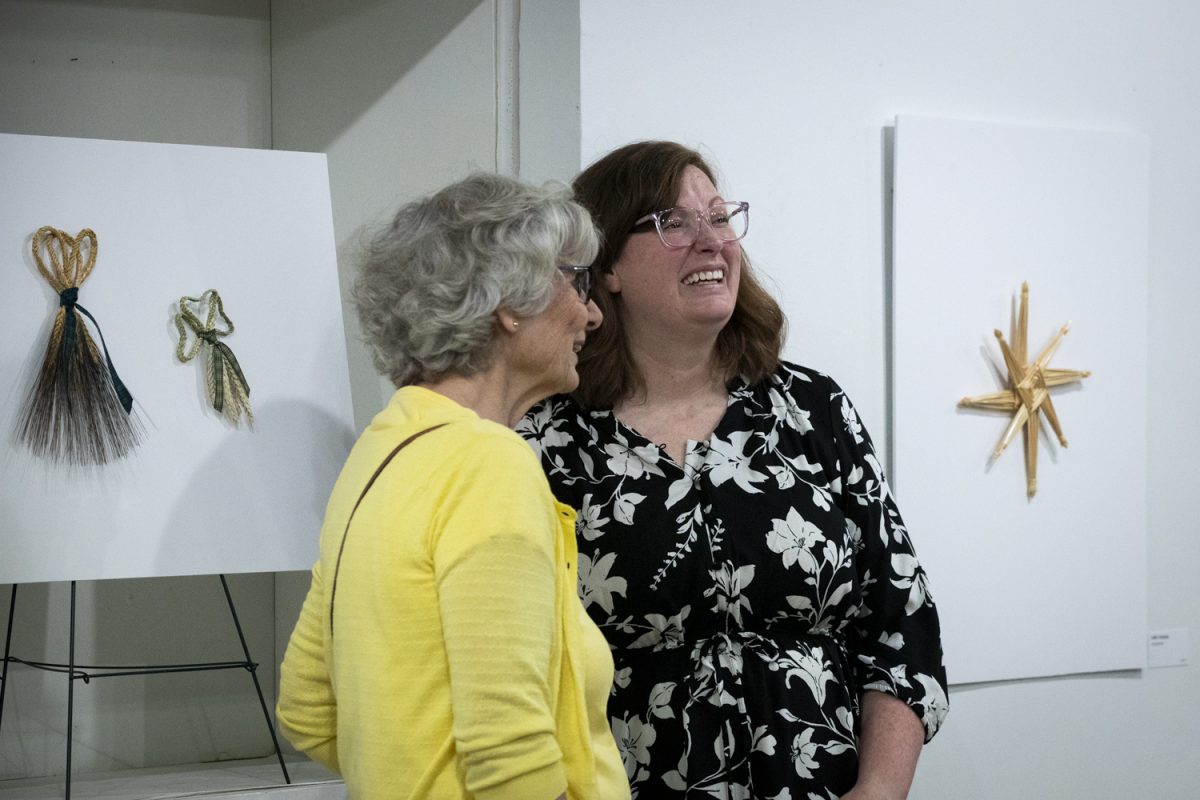Catharine Otto’s culturally rich work was showcased at Iowa City’s Artifactory in a gallery on Oct. 4. These unique installations are made entirely of wheat.
Cards distributed at the gallery featured information about the ancient wheat weaving process. Weaving served as a symbol of good luck, and the artwork symbolized strong connections with the Earth, one’s ancestors, and the spirit of a happy home.
Behind each of the 3-D pieces were stories that have been a great source of influence since Otto was a little girl.
One of the works was of two woven wheat squares, with four protruding wheat prongs attached to them from all directions. The upper one was smaller than the one near the bottom of the canvas. Called “St. Brigid’s Cross,” this symbol was a part of Otto’s childhood.
“The one thing I connected with was my heritage. I grew up in an Irish Catholic family, [and] my first wheat project was [a] St. Brigid’s Cross,” Otto said.
According to Blarney Wooden Mills, the cross was thought to keep away evil, fire, and hunger from the homes where it was put on display.
“As you get older, you explore what religion means to you,” said Otto. “So, you’re like, I wonder where these symbols came from. Growing up, you follow the trend[s], and then eventually you’re like, ‘No I think these are [symbols] I connect with.’”
It was surprising to realize that Otto had only gotten into wheat work in 2020, considering the breadth of artistry on display. But before that, she had grown up loving creating art out of scrap materials.
“Even as a little kid, I would have scrap fabric and sew it together. Whatever kind of things you could find, I was always cutting [them] up, usually newspapers or things that were discarded, and making new things out of them,” she said.
RELATED: The Secrest Barn promotes a sense of calm for Artifactory’s Plein Air art group
Otto’s exhibit did not only consist of wheat works on canvases. She had made hanging snowflakes out of rye, a figure representing Ceres, the goddess of agriculture and the harvest, and a woven crown. Almost every piece was made of a different type of wheat, including larned, black-bearded, turkey red, and blonde bearded.
Wheat was a medium that Otto was able to connect with because of the specificity of its texture.
“[It’s the] movement of it, the natural fiber. I sort of like how it’s not going to be around forever. You won’t find too many wheat-weaving pieces in history. Everybody knows what wheat is, but I feel like we take it for granted. You know, historically, it was something that was more sacred,” she said.
One of the most intricate pieces on display was Otto’s rendition of the Harvest Spirit. She combined black and blonde bearded wheat to make a creature resembling a firework.
“Agrarian cultures saved the last sheaf of wheat because they thought that a spirit lived [in it] and it [would be] good for the next year’s harvest. They thought they had to do certain things to get something to grow, [and] they would save the wheat with the wheat heads on it [along with] the seed and sow the seed of the crop next year because of superstition,” she said.
Otto obtains varied types of wheat from states like Arizona and Kansas. The time to make her pieces varies based on how small or large they become, but the average amount of time she spends on one work is three to four days.
“It’s sort of surreal, a little bit. You just kind of do something [and] you’re like, ‘This is fun, this is cool, and I know it’s different,’” Otto said. “It’s unique and I’m glad to show people this.”



